14 Ingredients To Boost The Fiber In Your Recipes, According To A Plant Nutritionist
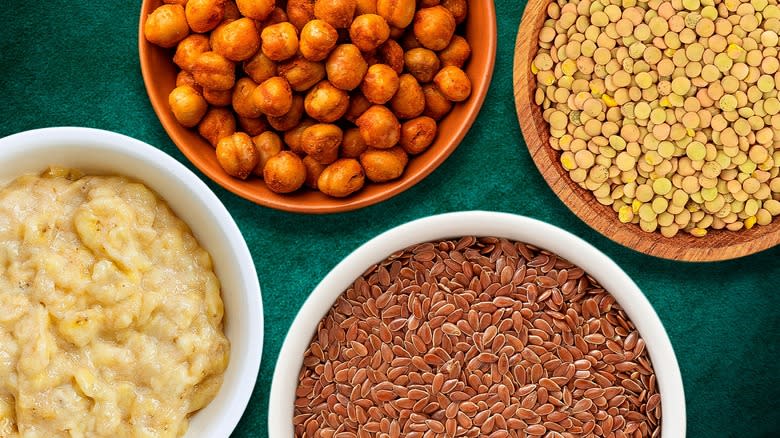
Protein. Protein. Protein. It's all anyone talks about when it comes to nutrition. And although protein is essential, it's typically not difficult to meet the suggested intake requirements if you're consuming enough food in a day. Only a very small population of Americans get less protein than recommended according to the National Institute of Health (NIH). However, the NIH also reports that only 5% of the population is getting adequate fiber in their diet, leaving the other 95% deficient.
Low-fiber diets can lead to inflammation, which can, in turn, lead to an increased risk for non-communicable diseases. Fiber is fuel for the gut, and a healthy gut microbiome can keep all systems running smoothly from your heart to your brain to your digestive tract. But how can you be sure you don't fall into the striking majority of the population that doesn't get enough fiber in their diets?
After getting my Plant Based Nutrition Certification from Cornell University and designing meal plans and products to help reverse and prevent disease, I couldn't help but notice how many people could solve a wealth of their health issues simply by eating more plant-based whole foods. But the truth is, many people don't know where to start. There are plenty of ingredients you can add to your favorite recipes to help boost your fiber intake and keep your body in tip-top shape. And luckily for us, most fiber-licious foods are quite tasty and can boost the flavor of your food as well.
Read more: 30 Healthy Snack Ideas That Won't Ruin Your Diet
Add Flaxseed To Your Smoothie

If you're downing a smoothie in the morning then you're already on the right track. Fruit is loaded with healthy digestible fiber. This fiber helps all of that glucose slowly release into your bloodstream to be used for energy, instead of spiking and crashing like it would with a soda or candy bar. Blending up a smoothie in the morning is an especially good idea to keep things moving and prevent constipation. A great way to boost your fiber intake even further is to add flax seeds to your smoothies.
Flax seed has a mild nutty flavor that won't disrupt the composition of your drinkable breakfast. It also absorbs liquid, which can help your smoothie keep its structure even on a warm day. Consider using ground flax seed (known as flax meal) to help get the most out of the seed. Your body won't break up the whole seeds, so they may come out the other end looking like they did going in.
Not only is flax a high-fiber food but it's also loaded with omega-3 fatty acids. The benefits are endless, so add ground flaxseed to your favorite breakfast drink, or try a decadent and healthy black forest smoothie recipe. If you don't love the flavor or texture of flaxseed, opt for chia seeds, which have similar dietary benefits and can be added whole or ground to your smoothie.
Include Green Lentils In Your Soup

Although soup season only comes around once a year, we like to enjoy it in winter, spring, summer, and fall. The best part about soup is that you can pack it with ingredients. Soup can be made out of any fruit, vegetable, grain, or meat, so it's a great option for those of us with overflowing gardens or CSA memberships, and people who love a bulk deal at the grocery store. While lentils are typically reserved as a meat replacement in soup, we think the two can coexist in a very delicious way. Both vegan and meat-heavy soups can benefit from the fiber-packed little legumes in both flavor and nutrition.
Consider using green lentils in your brothy soups. They tend to hold their form and become tender and chewy with a texture that can enhance any recipe. Green lentils absorb broth, so add them once your broth is established with herbs, spices, and aromatics. Feel free to add them raw and let them cook right in the soup. For a creamier soup, yellow and red lentils tend to fall apart when cooked, and can even help you thicken the creamy broth while adding buckets of fiber. In fact, 1 cup of cooked lentils is loaded with over 15 grams of fiber. That's over half of your recommended daily fiber requirements of 25-30 grams. It's time to fall in love with lentil recipes.
Swap Alfredo Sauce For Cashew Cream
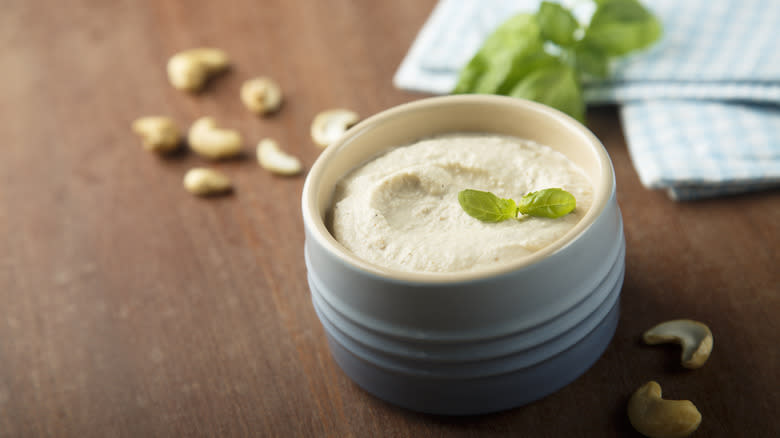
Fiber comes exclusively from plants, which means that meat, eggs, and dairy contain 0 grams of dietary fiber. A great way to ensure that you are reaching the required intake of fiber is to replace some of your meat and dairy favorites with plants. Now, we aren't suggesting that you must cut out meat and dairy, but a few swaps wouldn't hurt. Or perhaps even a meatless Monday. An easy swap (that's just as fun to make as it is delicious) can be accomplished by replacing Alfredo sauce with a cashew cream sauce.
We all know Alfredo sauce isn't considered a health food, but imagine making a version that is. Pasta Alfredo every night? Yes, please! To make your own cashew cream to use in your cooking, start with raw, unsalted cashews. Soak them in water overnight in the refrigerator, or in warm water until soft. Blend them with water, lemon juice, and a pinch of sea salt in a high-speed blender until creamy, and then blend for another 30 seconds for good measure. Mix with roasted garlic, cooked onions (or onion and garlic powder), nutritional yeast, salt and pepper, a tiny dash of sweetener, and lemon juice. Enjoy this fiber-rich, decadent comfort food while benefiting your body at the same time.
Blend White Beans For A Sandwich Spread

When you think of a fiber-filled food, sandwiches typically don't come to mind. Yes, you can use whole-grain bread and layer it with some lettuce and tomato, but unless you're planning a loaded vegetarian sandwich then you may want to add some additional fiber-filled ingredients. Try adding a white bean spread to your savory sandwich. White beans are incredibly mild and creamy so they won't overpower whatever flavors you're bringing to the table. Their water content can help add moisture to a dry mouthfeel, and the starchiness of the spread can even help to hold slippery ingredients like avocado and tomatoes in place.
Simply blend or mash white beans and use the spread for a subtle, yet pleasing fiber spike. However, you can also use this dairy-free creamy addition in your favor in the flavor department. Mix with herbs and spices to complement your sandwich. Include lemon juice to add some acidity, or mash the beans with roasted garlic or chili oil to give it a spicy kick. Fresh herbs can always be blended with white beans, which can add color and refreshing flavor. If you're looking to add some aesthetic appeal, blend white beans with turmeric or beets to add color. No matter how you mix it, you can't go wrong.
Add Prunes To Your Poultry Recipe
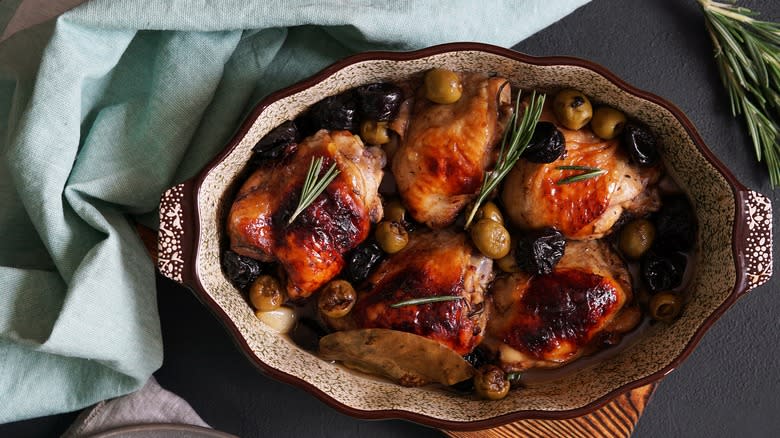
The sweet and savory combination of meat and fruit is common across cultures when it comes to cuisine, and there is a reason for it. The duality of the two flavors creates a very pleasing mouthfeel -- exciting different receptors on the tongue at the same time -- which curates a desirable balance. This is why chutneys are so popular, and why we can't stop adding pineapple to our barbecue. Fruit, as we know, contains quite a bit of fiber. But when it comes to getting things moving in the digestion department, prunes are notorious.
Prunes are simply dried plumbs and have an almost balsamic or molasses-like sweetness to them. They are chewy and jammy, but when cooked with liquid can swell back up to become quite juicy. Consider pairing prunes with gamey meats to match their intensity. Prunes go especially well with gamey poultry. The sweet and savory combination will captivate anyone enjoying the dish, and the soft and juicy texture will allow the meat and fruit to share juices and incorporate beautifully when cooked.
Use Mashed Ripe Bananas In Baked Goods

There are endless reasons why you should add mashed ripe bananas to your baked goods. For starters, bananas are particularly sweet and can add healthy sugar to the recipe. In addition, bananas can act as a binder -- or even an egg substitute -- for those with an allergy, watching their cholesterol, or abstaining from animal products. Bananas also have a pleasing flavor, but the reason we love adding bananas to our baked goods is that they are loaded with fiber.
Just one ripe banana contains 3 grams of fiber. No wonder banana bread is such a hit! To use as an egg substitute, wait until your banana has become speckled with brown dots before peeling it and mashing it with a fork. Because eggs don't contain fiber and aren't sweet, this swap is a no-brainer. About ¼ cup of ripe mashed banana is equivalent to one egg. This will also add an element of density to your baked goods and works well with pancakes, too.
Mix Creamy Yellow Lentils Into Spreads And Sauces
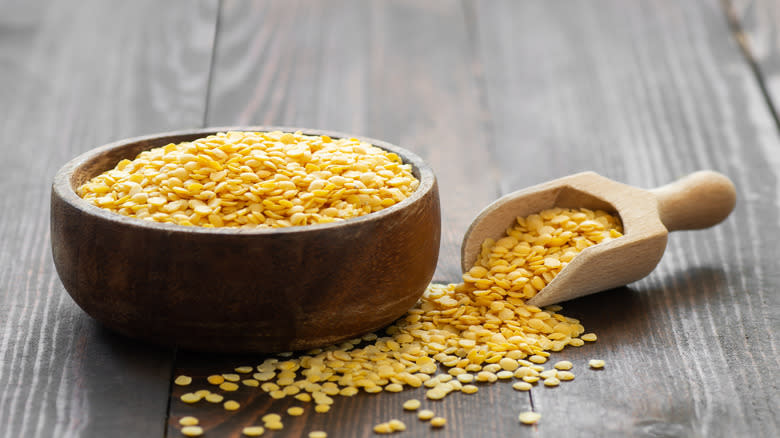
The beauty of spreads and sauces is that they can be used in many different capacities. Want to add a creamy swirl to your soup? Stir one in. Does your sandwich need some extra flavor? Spread it on. Is your chip or chopped veggie lonely? Dip it in! Much of the time, creamy sauces and spreads are made with dairy products. If you're looking to increase your fiber intake, consider cooking with yellow lentils in addition to (or instead of) your dairy base. Yellow lentils, unlike green or black lentils, tend to break down and become creamy when cooked. No mashing or blending is required. They are slightly grainy but have a pleasing density to them.
Consider adding just ½ cup of cooked yellow lentils to your favorite dip or spread recipe. This would add a whopping 8 grams of fiber, which is over a quarter of your recommended daily intake. Keep in mind that both red and yellow lentils may be mild in flavor, but could change the color of your recipe. Blend in other colorful spices and ingredients like beets to cover up any displeasing coloring.
Sprinkle Roasted Chickpeas On A Salad

As groceries become more and more expensive, it's less appealing to add prosciutto, crumbled bacon, and roasted nuts to achieve that salty kick your salad needs. However, beans are an inexpensive way to get the job done, and they are loaded with nutritional benefits like fiber. But we know what you're thinking ... beans aren't salty or crunchy. Don't fear: Crunchy, salty, roasted, or air-fried chickpeas are all the rage and we can help you hop on the trend.
Start by draining your chickpeas and patting them dry with a clean cloth or paper towel. Then, toss them with a little oil and some spices. If you're unsure where to start in the spice department, play it safe with salt, pepper, paprika, and garlic powder. Roast them on a high heat until they begin to brown. Be sure to give your pan a little shake to help rotate the beans about halfway through the cooking process. These fiber-filled beans will be sure to give any salad a crunchy, salty, flavorful kick. Try adding them to your Caesar salad instead of croutons, or add chickpeas to your Waldorf salad for a protein-packed bite.
Blend Pears For An Alternative Sweetener
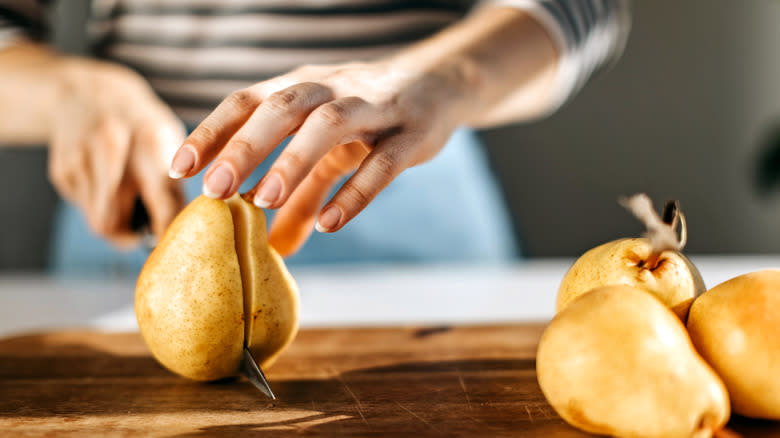
When babies are having trouble going number two, it's no wonder pediatricians recommend a little pear juice to get things moving. Pears are loaded with fiber, but they also have a honey-like sweetness that is tantalizing to the taste buds. If you are looking for sweeteners for cooking that aren't sugar, then blended fruit is a great place to start. Typically, folks try to avoid refined sugar because it can spike glucose levels rather aggressively, which can lead to sugar crashes, weight gain, and inflammation -- or even throw your pancreas out of whack.
Pears are very water-dense, so if you blend them you will end up with a sticky-sweet, thick liquid that can be used to sweeten anything from drinks to baked goods. You can even use pear juice in a meat glaze or salad dressing. Feel good about incorporating more fiber into your diet while still enjoying super sweet treats.
Use Oat Flour In Your Baked Goods

Gluten-free folks will deliver a long list of flour alternatives for baking, from chickpea flour to buckwheat. However, a top pick for a chewy and hearty outcome just so happens to be something almost everyone keeps stocked in their pantry. Oatmeal can easily be made into oat flour simply by blending until it becomes fine. Oat flour is very water-absorbent, so you may have to change a few liquid and dry ingredient ratios around. It works particularly well with breads, muffins, and pancakes, as it has a robust texture and flavor.
Oat bran is another option, as it is slightly less chewy and can be more finely ground. It's the simple addition that gives your baked goods more fiber, without changing the whole composition of the recipe. Try starting your day off with an oat bran muffin, and you may just find that it sticks with you much longer than a white flour one.
Make Chickpea Flour Pancakes
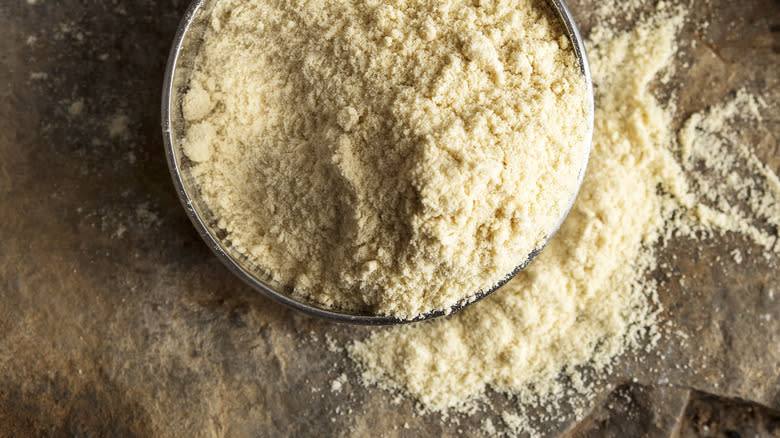
Pancakes are a brunch staple, but the standard recipes don't tend to be particularly fiber-dense. That doesn't mean that you have to change your traditions. Make super sweet, fluffy, delicious pancakes using chickpea flour. We know that you're probably wondering how the heck a bean could possibly make pancakes, but don't knock it until you try it. There's a reason that those who can't have gluten choose chickpea flour for the best texture when baking gluten-free treats. Unlike oat flour, it's finely ground and light. Whatever you do, avoid tasting the batter before it's cooked thoroughly because raw chickpea flour is rather bitter.
As we know, beans are one of the most fiber-packed foods out there. Imagine eating sweet fluffy pancakes for breakfast and getting multiple servings of your daily vegetables and fiber (without even tasting it). This is a great option for kids who won't eat their veggies, or for adults who love a good hidden ingredient. The best part is that no eggs are required; chickpea flour is quite binding, so the recipe couldn't be easier. All you need is chickpea flour, milk or non-dairy milk, salt, baking soda, a sweetener of choice, and vanilla extract. Sunday morning just got a lot healthier.
Choose Lentil Or Spaghetti Squash Pasta
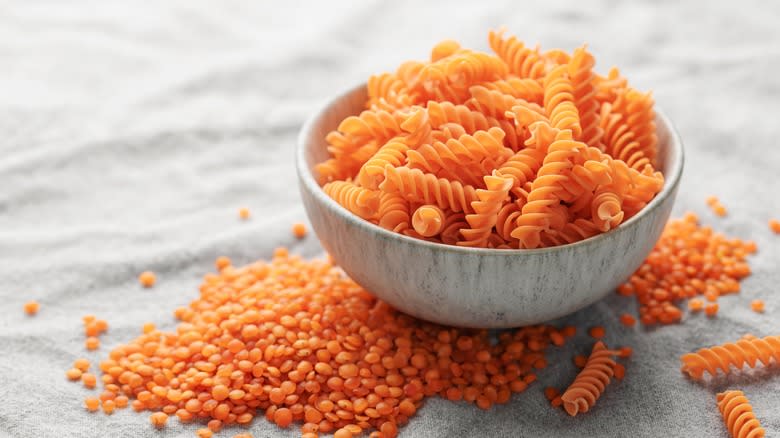
Don't reserve comfort food for rainy days or breakups. You should enjoy it whenever possible, because who doesn't love a spoonful of food that feels like a warm hug? Pasta is a favorite amongst most people, and luckily there are ways to turn your go-to pasta recipes into a fiber-loaded meal. Of course, using whole-grain pasta will get you part way there, but these days there are plenty of alternatives to choose from. One of the best-textured pasta alternatives is lentil pasta. It stays together nicely without getting crumbly or mushy. And even better, it's loaded with fiber.
If you can feel your Italian ancestors rolling over in their graves, try the anti-pasta trend by using spaghetti squash instead. It's far enough away from pasta that it's unlikely you'll be comparing the two (nobody is expecting squash noodles to taste like a classic pasta recipe). However, spaghetti squash is packed with fiber. And this pasta substitute is so deliciously sweet and tender that it might just become your new favorite. Spaghetti squash lasagna boats are so irresistible, you may never go back to boiling pasta water again.
Swap Cream Cheese With Avocado
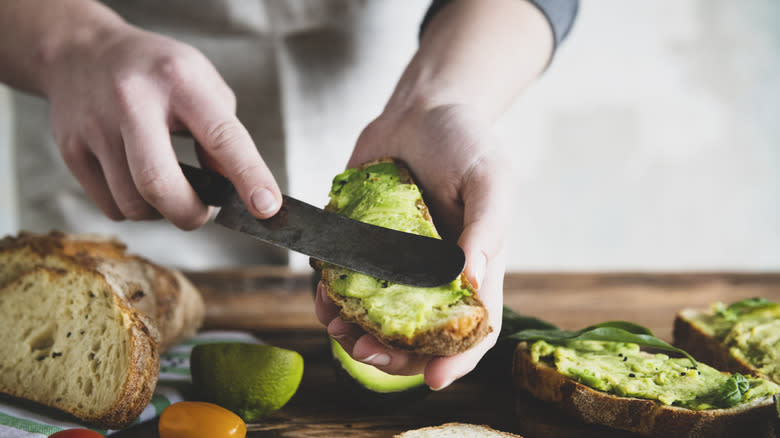
Don't get us wrong, there's nothing better than a bagel with cream cheese first thing in the morning. But cream cheese doesn't do too much for our guts. There is an alternative spread that is just as fatty and creamy but is considered a superfood. Avocado toast may have become famous for its decadent texture and loveable flavor, but it's also a perfect breakfast food for its nutritional value.
Any toast or bagel can be topped with mashed or thinly sliced avocado. Add lemon juice, salt and pepper, garlic powder, or chili oil to enhance the flavor. A little everything-but-the-bagel seasoning is a simple ingredient to elevate the flavor and texture of avocado toast. Half an avocado has almost 5 grams of fiber... and realistically, who's out there not finishing the whole thing? Choose a ripe avocado by letting it soften enough to give slightly when pressed. If you find yourself with a surplus of ripe avocados (as they tend to be infamously unpredictable), stash them in the refrigerator to lengthen their lives.
Top Treats With Shredded Coconut Meat
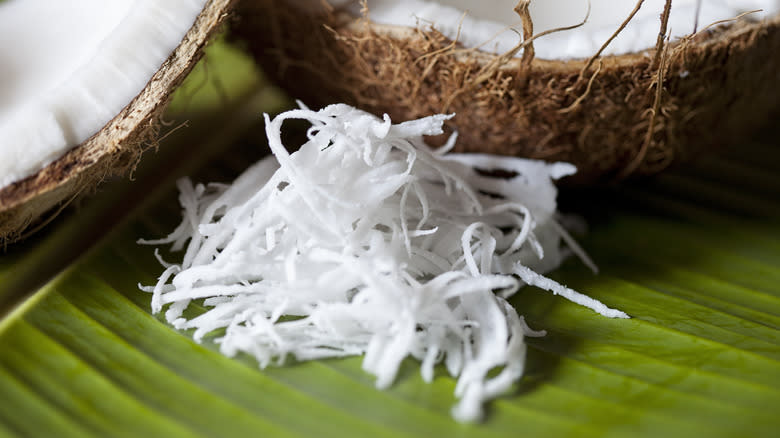
Not only is coconut meat incredibly chewy and sweet, but it happens to be a great way to boost your fiber intake in recipes. Consider using toasted coconut shreds to top your cakes, cupcakes, muffins, oatmeal, smoothie bowls, or chia pudding cups. Coconut flour or coconut shreds can be used to coat energy balls or stuffed dates to prevent them from sticking together. Coconut flour is a tricky swap in baked goods because its texture is quite different from white flour, and it tends not to bind well. But don't let that stop you. Find coconut flour baked goods recipes (like these gluten-free tarts) that are designed specifically with the flour alternative in mind.
Consider making chewy sweet coconut bars for a fiber-filled snack or dessert that you can bring on the go. These are great for kids and athletes who have lots of energy to burn and could use the extra fiber boost. Just 1 cup of coconut contains 7 grams of fiber so keep coconut in mind when you're ready to get serious about eating more fiber.
Read the original article on Tasting Table


